Do Hawks Hunt at Night? Ever wondered what common nighthawks and owls get up to when the sun goes down? Prepare to be amazed as we delve into the hidden world of these magnificent birds of prey after dark.
Contrary to popular belief, hawks don’t simply retire at night; they become skilled predators, especially the raptor species.
Join us as we unravel the mysteries of hawks’ nocturnal hunting habits, exploring their unique adaptations and mesmerizing hunting techniques under the moonlit skies.
Embark on this captivating journey into the enigmatic world of hawk hunting after dark.
The Hunting Habits of Hawks: Day vs. Night

Comparing the Hunt: Daytime vs. Nighttime
Hawks are fascinating creatures known for their exceptional hunting skills. But have you ever wondered how these animals differ in their hunting habits depending on the time of day?
Let’s explore hawks’ unique strategies during daytime and nighttime hunts, along with the advantages and challenges they face in each scenario.
From prey migration patterns to using their talons effectively, hawks adapt to their surroundings and make the most of their habitat, despite the threat of habitat destruction.
During daylight hours, hawks exhibit diurnal hunting behavior, meaning they primarily hunt small birds during the day, including songbirds.
This preference is influenced by various factors such as prey availability, visibility, and prey migration patterns. Early morning is a particularly active time for hawks to hunt, as many songbirds are active during this time.
Hawks capitalize on the abundance of daylight to spot potential targets from high vantage points such as trees or telephone poles, even though they are known to be active at night as well.

In contrast, some red hawk species have adapted their talons to nocturnal hunting to take advantage of prey that are more active at night.
The nocturnal hawk is a prime example of this adaptation, with its sharp talons and keen eyesight allowing it to hunt effectively in the dark.
The red tailed hawk is another species that has adapted its talons for hunting, but it primarily hunts during the day and is known for its distinctive red tail feathers.
These nocturnal animals possess remarkable night vision capabilities, allowing them to navigate through low-light conditions effectively.
Their eyes contain specialized cells called photoreceptors that are sensitive to low levels of light, enabling them to see in the dark with sharp vision.
By relying on their acute eyesight and honed hunting instincts, nocturnal red hawks can detect movements even in dimly lit environments.
Related Article: Can Owls Fly in Rain?
Uncovering Nighttime Strategies
Hawks utilize their sharp talons and employ various hunting behaviors to effectively capture birds during the night.
They are often found perched on a tall tree, scanning the area for bird of prey with their keen eyesight. The tall tree provides a perfect canopy for them to observe their surroundings.
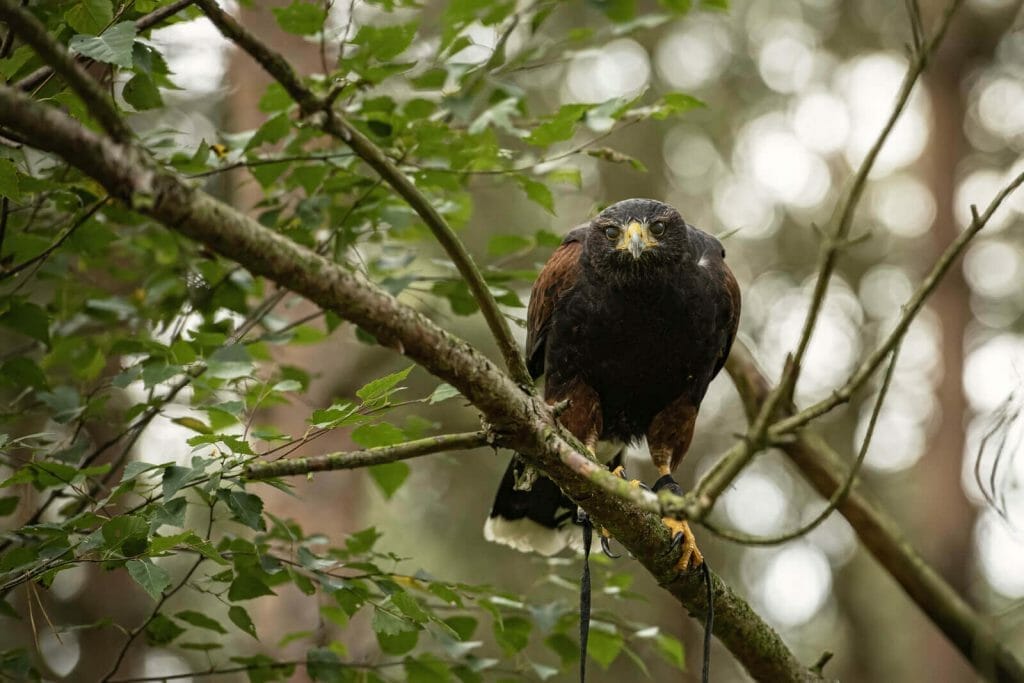
- Silent Soaring: Nocturnal hawks often rely on silent soaring techniques while hunting for food, especially birds, at night. By gliding noiselessly through the air, they minimize detection by unsuspecting prey below and exhibit their natural hunting behavior.
- Stealth Attacks: Taking advantage of darkness and reduced visibility, tailed hawks, buteo hawks, and accipiter hawks typically hunt by executing stealthy attacks, swooping down swiftly onto unsuspecting prey.
- Enhanced Hearing: In addition to superior vision, many nocturnal hawks possess exceptional hearing abilities that aid them in their hunting behavior at night, allowing them to locate small mammals scurrying about in the dark. These birds of prey rely on their enhanced hearing to track and capture their targets.
- Dusk and Dawn Activity: Some tailed hawks, buteo hawks, and accipiter hawks display increased activity during dusk and dawn when light levels are optimal for spotting movement but still provide an element of surprise for hunting prey.
Related Article: Owls With No Feathers
Do Hawks Hunt at Night: Factors Affecting Hawk Hunting Behavior
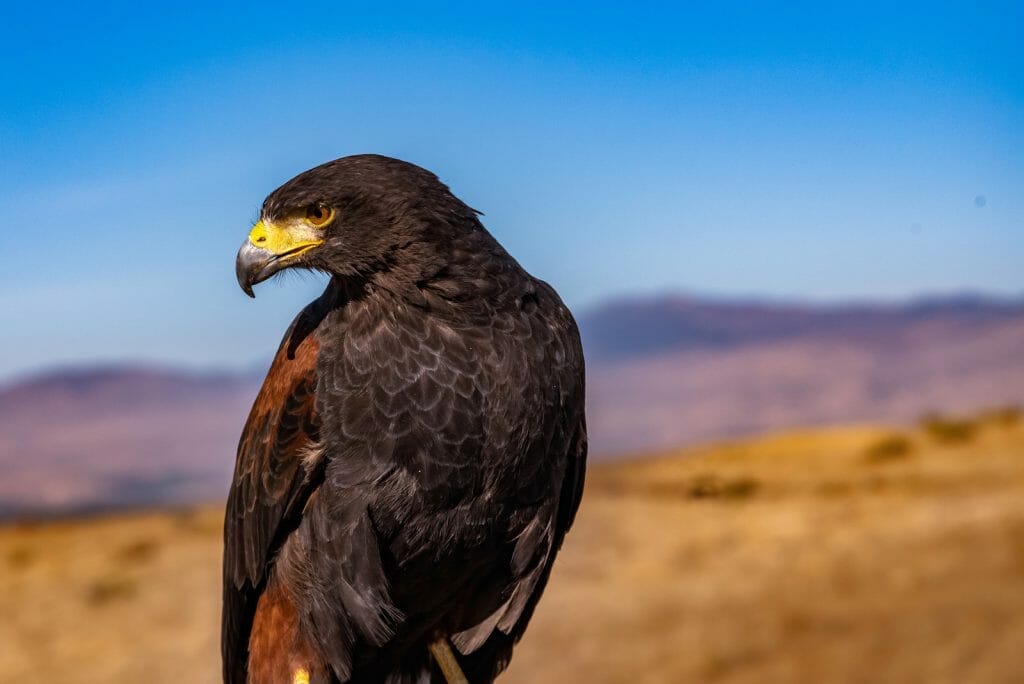
Weather Conditions: A Game Changer for Hawks
Weather conditions, especially at night, play a significant role in determining the hunting patterns of hawks.
These majestic birds are highly adaptable predators, but they do face challenges when it comes to catching prey with tough hides or feathers. Using their sharp talons and razor-sharp beaks, hawks are able to tear through the toughest of prey.
Strong winds can make it difficult for hawks to soar and maintain their balance while hunting at night. Similarly, heavy rain or snow can impair their visibility, making it harder to spot prey from above during the night.
On the other hand, certain weather conditions can actually work in favor of hawks’ hunting behavior.
For instance, during periods of low atmospheric pressure or temperature inversions, air currents become more stable.
This stability allows hawks to glide effortlessly through the sky as they search for potential meals below.
An increase in humidity can enhance the scents emitted by prey animals, making them easier for hawks to detect, especially at night.
Related Article: How To Identify Bald Eagle Feathers
The Crucial Role of Lighting in Hawk Hunting Success

Light conditions, especially at night, have a significant impact on hawk hunting behavior. Hawks, known for their exceptional vision, rely on lighting to spot potential prey from high altitudes.
During daylight hours, birds like hawks have a distinct advantage with their keen eyesight. They can identify small movements or flashes of color that may indicate the presence of prey animals below.
However, as night approaches and light levels diminish, hawk hunting becomes increasingly challenging for these birds.
Nevertheless, some species of hawks have adapted their hunting behavior to prey on birds during twilight hours or even at nightfall when lighting conditions are less favorable.
These nocturnal hunters possess specialized adaptations such as larger eyes with enhanced light-gathering capabilities and an increased number of rod cells responsible for low-light vision.
Environmental Factors: Shaping Hawk Hunting Habits

Apart from weather and lighting conditions, environmental factors significantly influence the hunting behavior of hawks.
One of the key factors is the habitat where these birds choose to hunt their prey, especially at night.
Do hawks usually hunt in groups during daytime or nighttime?

Hawks usually hunt solo or in pairs during the daytime because they rely on their incredible eyesight to locate and capture their prey.
Although some species like the Harris’s will hunt in groups. Since they are diurnal, they typically do not hunt at night.
Are hawks or other birds of prey known to have good night vision?
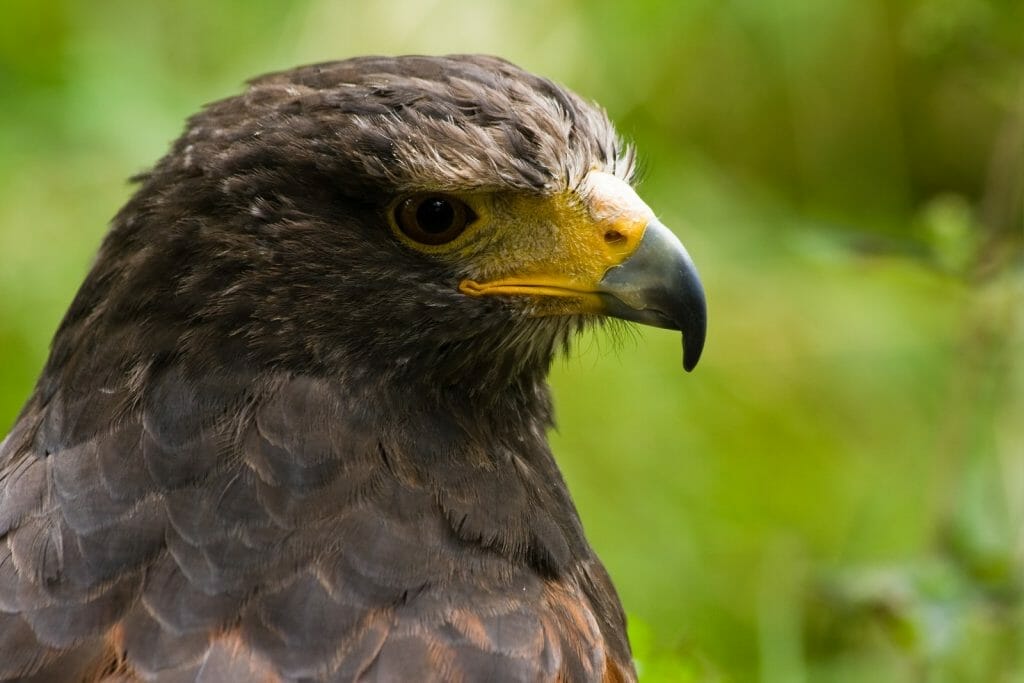
Hawks generally do not have good night vision compared to nocturnal birds of prey like owls.
Hawks possess remarkable visual acuity, surpassing that of humans by a factor of 8, making them stand out in this aspect.
They rely on their excellent daytime vision to locate and capture prey, which makes them less effective hunters during nighttime hours.
Feeding Habits of Hawks: Timing and Frequency
Hunger Levels and Prey Seeking
Understanding the timing and frequency of hawk feeding behaviors at night can provide valuable insights into their dietary habits.
One key factor that influences when hawks seek out prey at night is their hunger levels. Just like us, hawks have varying degrees of hunger throughout the day and at night.
When a hawk’s hunger strikes, its hunting behavior kicks in. Buteo hawks and Accipiter hawks become alert and focused, ready to seize any opportunity that comes their way.
So, if you spot a hawk soaring through the sky at night in search of its next meal, chances are it’s feeling quite famished.
Factors Affecting Hawk Feeding Habits
While hunger plays a significant role in determining when hawks engage in hunting behavior, there are other factors that can cause variations in their feeding habits.
Let’s explore some of these factors, such as the type of prey they target and their preference for hunting at night.
| Factor | Description |
|---|---|
| Time of Day | Hawks are diurnal creatures, meaning they primarily hunt during daylight hours. Their keen eyesight allows them to spot potential prey from great distances while soaring high above the ground. |
| Species Variation | Different species of hawks may exhibit slightly different feeding patterns based on their specific dietary preferences and adaptations. |
| Seasonal Changes | The availability of prey can vary with the changing seasons, influencing when hawks choose to hunt. For example, during winter months when food sources may be scarce, hawks might adjust their hunting behaviors accordingly. |
| Environmental Conditions | Weather conditions such as heavy rain or strong winds can impact a hawk’s ability to successfully catch its prey. In adverse weather conditions, hawks may postpone hunting until conditions improve. |
| Territorial Behavior | Hawks defend specific territories where they find ample food resources. |
| Hunger | Hunger plays a significant role in determining when hawks engage in hunting behavior. |
| Type of Prey | Hawks may have preferences for specific types of prey, influencing their feeding habits. |
| Nocturnal Behavior | While hawks are primarily diurnal, some species exhibit nocturnal hunting behavior, preferring to hunt at night. |
Nocturnal Behavior: Where Do Hawks Sleep at Night?
Hawks’ Preferred Roosting Locations
When the sun sets and darkness takes over, these majestic birds of prey seek out suitable spots to rest and sleep.
Understanding where hawks prefer to roost during nighttime hours can provide valuable insights into their behavior.
- Trees: One common roosting location for hawks is trees. These tall structures offer safety, protection, and a vantage point from which they can survey their surroundings. Hawks often choose sturdy branches or dense foliage that provides cover while they rest.
- Cliffs and Rocky Outcrops: In areas with rugged terrain, hawks may opt for cliffs or rocky outcrops as their preferred sleeping spots. These elevated positions allow them to keep an eye on potential prey while remaining hidden from predators.
- Power Poles and Transmission Towers: Some urban-dwelling hawks have adapted to the presence of humans by utilizing man-made structures as roosting sites. Power poles and transmission towers offer elevated perches that mimic the height advantages provided by natural settings.
Factors Influencing Habitat Selection
The specific habitats favored by sleeping hawks after dark are influenced by various factors that cater to their needs, ensuring both safety and comfort throughout the night.
These factors include:
- Protection: Hawks prioritize locations that provide protection from potential threats such as other predatory animals or adverse weather conditions. Trees with dense foliage or cliffs with overhangs serve this purpose well.
- Visibility: Being able to maintain a clear line of sight is crucial for hawks even when they are resting. Therefore, they tend to choose roosting spots that offer a good view of their surroundings, allowing them to quickly detect any movement or potential prey nearby.
- Proximity to Hunting Grounds: So, hawks like to find spots to rest where they can see everything around them easily. This way, they can spot any movement or possible food nearby.
Pet Safety: Protecting Your Pets from Hawk Attacks
Signs of a Potential Threat
As a responsible pet owner, it’s crucial to be aware of signs indicating that a hawk may pose a threat to your beloved pets. Keep an eye out for these common signs.
- Unusual hawk behavior: If you notice hawks circling low around your property or perching on nearby trees for extended periods, it could be an indication that they are scouting for potential prey.
- Increased presence of small rodents: Hawks are attracted to areas with abundant food sources. If you’ve noticed an increase in small rodents such as mice or rats in your vicinity, it might attract hawks looking for an easy meal.
- Frequent sightings of hawks: Regularly spotting hawks in your neighborhood could suggest that they have established their territory nearby and might view your pets as potential targets.
Safeguarding Your Pets
Let’s explore practical tips and measures you can take to create a secure environment for your furry companions when hawk attacks are a concern:
- Supervise outdoor activities: Keep a close eye on your pets when they’re outside, especially during dawn and dusk when hawks tend to be more active. Supervision helps prevent any surprise attacks and allows you to intervene if necessary.
- Provide adequate shelter: Ensure that your pets have access to secure shelters where they can seek refuge if threatened by a hawk or other predators. This could be a sturdy doghouse or an enclosed area designed specifically for their safety.
- Install physical barriers: Create barriers around vulnerable areas such as chicken coops or rabbit hutches using wire mesh or netting with small openings. These barriers will prevent hawks from swooping in and grabbing your pets.
- Keep small pets indoors: To keep hawks away from your pets, you can put up fences or nets around places where your pets stay, like chicken coops or rabbit hutches. This will stop the hawks from flying in and taking them. Also, make sure to keep your little pets inside the house where they’ll be safe!
Conclusion
Delving into the awe-inspiring realm of hawk hunting unveils a deeper appreciation for these majestic birds. From the break of dawn to the darkness of night, hawks showcase a diverse range of hunting habits.
As opportunistic hunters, hawks rely on their keen eyesight and unmatched agility to seize their next meal.
By unraveling these intricate patterns, we gain valuable insights into the captivating behavior of hawks. Understanding the factors that shape their hunting rituals leads us into an enchanting world where these magnificent creatures reign supreme.
FAQ
Why Are Hawks Important And Do They Hunt At Night?
Hawks are important because they play a vital role in controlling the population of small animals and birds.
However, hawks are diurnal birds, which means they usually hunt during the day and sleep at night. So, hawks do not hunt at night typically.
Are There Any Types of Hawks That Exhibit Different Hunting Habits And Hunt at Night?
Most hawks are known to hunt during the day, but there have been a few rare instances where some specific types of hawks were observed hunting at dusk or just after sunset.
However, this is not a common hunting habit for hawks.
What do hawks eat and can they see at night?
Hawks eat small animals and birds such as rodents, insects, rabbits, and squirrels.
Although hawks have good eyesight to spot their prey, they don’t typically have great night vision like nocturnal birds.
They rely on their keen sight, but it is not as effective to see at night.
Is Seeing a Hawk At Night an Uncommon Sighting?
Yes, seeing a hawk at night is an uncommon sighting because hawks are diurnal birds and they usually rest at night.
If you happen to see a hawk at night, it could be a rare instance or due to unusual circumstances, but it is not a part of their regular behavior.
What Type Of Prey Attracts Hawks To Hunt At Any Time Of Day?
Hawks are attracted to various kinds of small animals and birds like rodents, insects, rabbits, squirrels, and smaller birds.
The size of the prey usually determines the type of hawk that will hunt for it, with larger hawks preying on larger animals.
What Can Deter Hawks From Nocturnal Hunting?
Since hawks aren’t nocturnal and have limited night vision, they are deterred by the darkness itself and difficulty in spotting prey at night.
Hawks are most effective during the daytime when the natural light allows them to use their exceptional eyesight to locate and capture their prey.
Can The Hunting Habits Of Hawks Change If They Can’t Find Enough Prey During The Daytime?
Although hawks are diurnal, extreme circumstances due to scarcity of food could force them to try hunting at night.
They would still be less effective hunters at night due to their limited night vision, and it would not be their preferred time to hunt.
In Which Conditions May Hawks Be Seen Hunting At Night?
Hawks may be seen hunting at night in very rare cases, such as under certain artificial lighting which could illuminate enough to make the area visible for them.
This is not typical hawk behavior and should be considered an exception rather than a rule.
What Is The Difference Between Hawks And Owls?
Hawks and owls are both birds of prey, but there are several differences between them. Owls are nocturnal, while hawks are diurnal.
Owls have larger eyes and a broader head, allowing them to see better in the dark, while hawks have smaller eyes and a more streamlined head for hunting during the day.



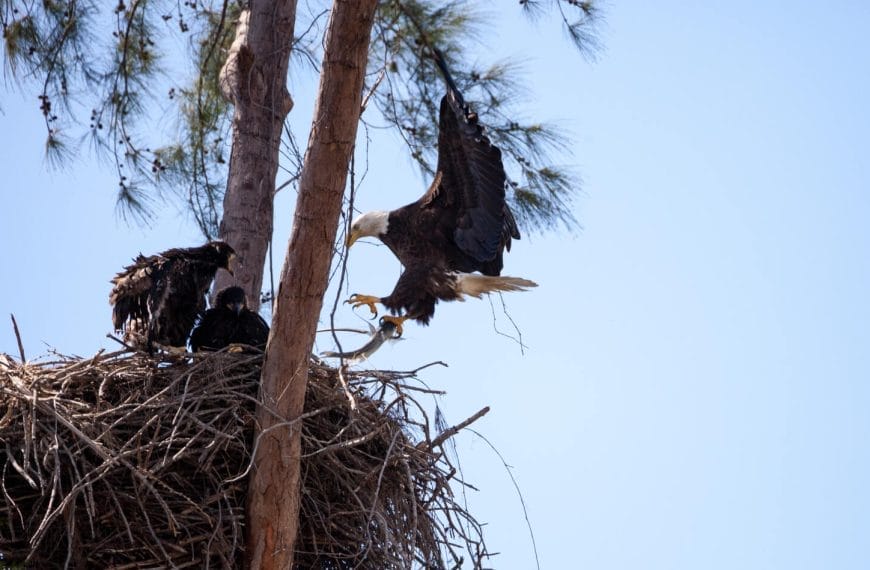

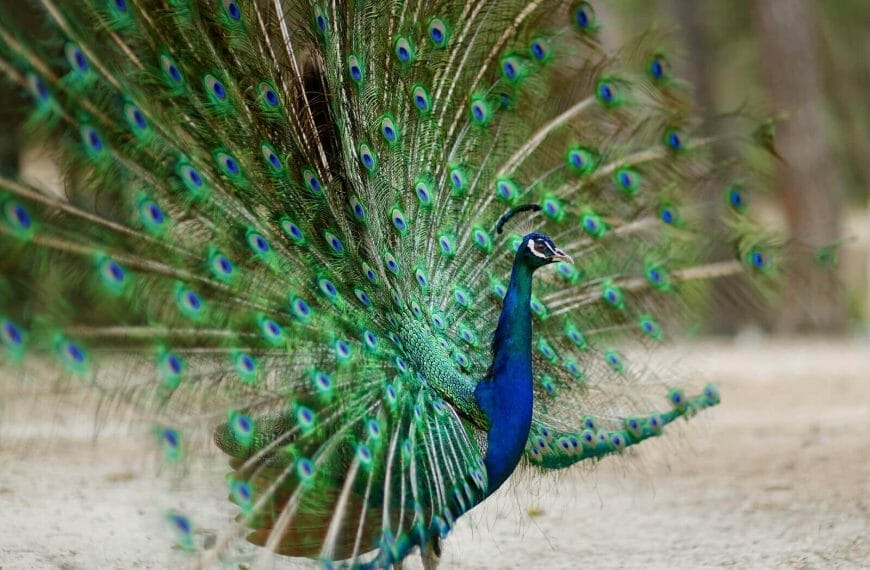
![How to Identify Turkey Feathers [Ultimate Guide]](https://ekz2dfuukk8.exactdn.com/storage/2023/03/HOW_TO_IDENTIFY_TURKEY_FEATHERS-793x570.jpg?strip=all&lossy=1&ssl=1)

![How to Keep Birds Off Your Boat: Ways and [Best] Deterrents to Keep Birds Away From Your Boat](https://ekz2dfuukk8.exactdn.com/storage/2023/05/how-to-keep-birds-of-your-boat-870x570.jpg?strip=all&lossy=1&ssl=1)








![How to Attract Ravens to Your Yard: The [Complete] Guide to Attracting these Beautiful Birds to your Backyard](https://ekz2dfuukk8.exactdn.com/storage/2023/10/How-to-Attract-Ravens-to-Your-Yard-870x570.jpg?strip=all&lossy=1&ssl=1)



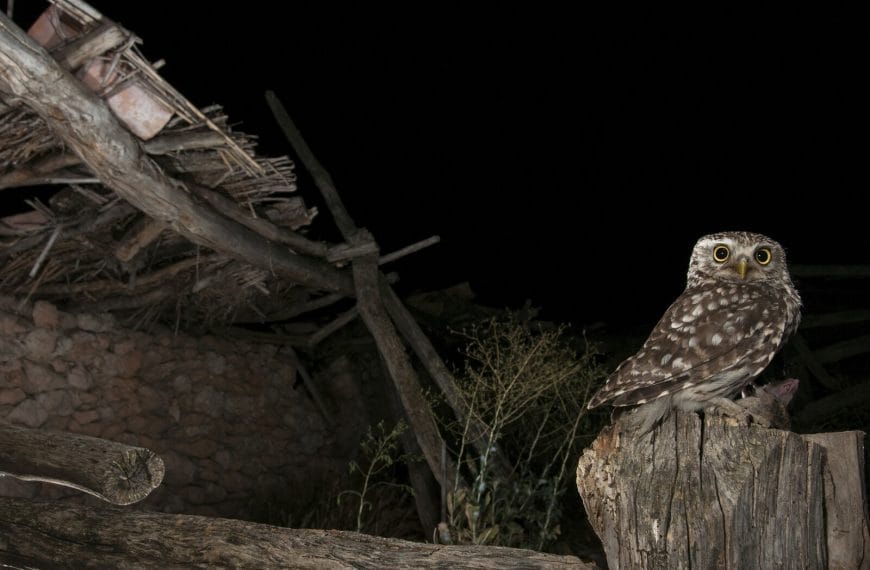



![How to Attract Ravens to Your Yard: The [Complete] Guide to Attracting these Beautiful Birds to your Backyard](https://ekz2dfuukk8.exactdn.com/storage/2023/10/How-to-Attract-Ravens-to-Your-Yard.jpg?strip=all&lossy=1&ssl=1)



